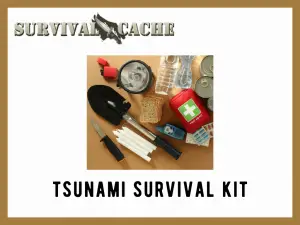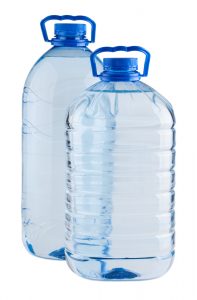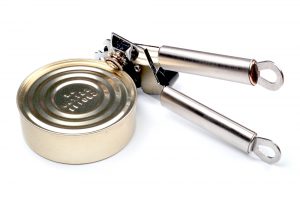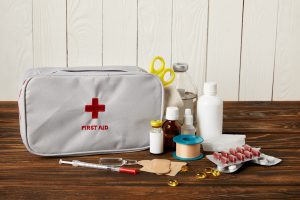According to Tsunami.Gov, tsunamis happen, on average, two times a year worldwide.
Generally speaking, these yearly tsunamis cause damage and deaths that are localized to the source of what caused the wave.

However, powerful tsunamis can travel hundreds of miles from the source on average twice every ten years.
In 2004, an earthquake in the Indian Ocean registered at a magnitude of 9.1 and caused a tsunami that resulted in the deaths of over 200,000 people and an estimated cost of damage at $15,000,000,000.
Depending on the source and your distance from it, there can be a tsunami warning issued or they can happen suddenly.
Because this type of natural disaster can be so devastating and at times unpredictable, it is imperative to be prepared for it whether you live near a coastline or you are just visiting.
Before preparing a survival kit it may be helpful to know a few things about tsunamis and how to deal with them.
SKIP AHEAD
Tsunami Preparations
What is a Tsunami?
A tsunami is a series of waves that happen in large lakes, sea, or ocean. They are caused by a large volume of water that is displaced through the effects of earthquakes, landslides either above or below the water’s surface, and volcanic eruptions.
Here’s a detailed video explaining how tsunamis work.
Before It Happens
As mentioned earlier, there can be an advanced warning of an incoming tsunami.
This warning depends on someone physically seeing a source event enfold or it being detected through scientific instrumentation.
Either way, once detection is observed a tsunami warning will be issued that will hopefully provide a population enough time to get to safety.
However, sometimes tsunamis are not detected early enough to give an advanced warning but if a person has good situational awareness, they can notice the main indicator of an incoming tsunami.
When a source event happens, i.e. an earthquake, there is a large displacement of water.
This displacement pulls water away from shorelines and out into the main body of water.
Water that recedes away from a shoreline drastically in a short amount of time is a strong indicator that a tsunami is occurring. When tis happens, you must get to safety quickly.
Tsunami Dos and Don’ts
When a tsunami happens, there are few things you can do or not do that will better your chances of staying safe.
- When a tsunami warning system has been activated, immediately move as far inland and to the highest elevation possible.
- If you are on a beach and notice the water level recede dramatically in a short amount of time, immediately move inland and to the highest elevation possible. DO NOT venture out into the low tide area to investigate what has been uncovered by the water.
- If you cannot get far inland then move to the highest floor of a building, including the roof.
- Tsunamis can be made up of multiple waves spaced minutes or an hour apart. Do not leave a safe location until the all-clear signal has been announced.
- When finding refuge in a building, stay away from windows and glass doors, especially when they are on the side of the incoming water.
- When possible, wait for floodwater to recede before venturing out as it can hide many dangers.
- Keep a watchful eye out for down powerlines as these lines can still have electricity running through them
Tsunami Survival Kit: Top 15 Items to Include
Because this event can happen quickly with little warning, a kit should either be portable and easily accessible or secured in a location that will keep the contents dry and protected.
A large pack that can be picked up and slung over the shoulder is ideal when having to flee to safety at a moment’s notice.
Here are some items that would be helpful to have.
Water
A minimum of one gallon per person per day for one week should be stored in a location out of the path of floodwaters. In addition to stored water, several methods for filtering, boiling, and purifying water needs to be available.
Non-perishable food
Power will most likely be knocked out in the event of a tsunami. For this reason, do not rely on refrigerated food or normal cooking methods. Store canned goods that can be eaten right out of the container or freeze-dried/dehydrated food that requires minimum preparation and cooking.
Manual can opener
Since canned goods are one of the best emergency foods to stockpile a manual can opener is a must-have tool.
Disposable cookware, plates, and utensils
Washing dishes will most likely not be an immediate option and clean water will be at a premium. Having disposable items in this category will make life easier and help to save precious resources.
Multitool, Pocketknife, Fixed Blade
These three great tools are easily carried in a bag or on your person. You never know what you will run into in a heavily damaged urban area and these tools can be used in a multitude of ways.
Check out our detailed look into multitools you can buy.
First Aid Supplies
General first aid kits that are bulked up are always a necessity. Have plenty of:
- Gauze
- Sterile Pads
- Clotting agents
- Multiple sizes of band-aids
- Antibiotics
- Antibiotic creams
- Clean wipes
- Tape
- Tweezers
- Scissors
- Alcohol pads
- Hydrogen peroxide
- General medications for reducing fevers, anti-inflammatories, anti-diarrheal, and pain relief
- Tourniquets
- Ace bandages
- Splints
- Clean water
- Eyes wash solution
- Hand sanitizer
- Disposable gloves
Cordage
This stuff is always extremely useful and a lot of small diameter, strong cordages like paracord or Kevlar rope are easily carried. However, thicker diameter ropes should be stored as well as they can be used for rescue lines and other purposes.
Signaling Devices
In an environment that has been devasted by floodwaters, people can easily become stranded on top of buildings or trapped within structures.
Having numerous methods for signaling for help will expedite rescue efforts. A few signaling devices to include are flares, brightly colored flags, signal mirrors, emergency whistles, and bright flashlights.
Communication
Alternative means for communicating or receiving information are a must. Signaling devices as listed above are a part of this but other items to include are two-way radios, AM/FM emergency radio, satellite phone, HAM radios, pens/pencils/markers, and paper.
Footwear
While it is not advised to walk through floodwaters, sometimes there is no choice. If you must do this make sure to wear proper footwear that will keep you dry and protected.
Floodwater can play host to an array of harmful bacteria and chemicals as well as camouflage physical hazards under the surface. Having a pair of thick, durable shoes, boots, rubber boots, hip boots, or waders will help keep you dry and safe.
PPE
Just like the footwear above, there are a few other items that can help to keep you protected in a dangerous environment. They can include eyewear, joint pads, masks/respirators, and heavy-duty gloves.
Life Preservers
Considering that floodwaters can move vehicles and buildings, people caught up in its path can easily be swept away.
Life preservers will aid in keeping a person’s head above water, will help in expending less energy while swimming, and can make a person more visible during rescue efforts.
Emergency Fire
Utilities may be shut down or a person may be stuck far inland where the ability to make a fire will help to keep warm, cook food, boil water, and signal for help.
A few tools for making fire should be in the kit. They include lighters, stormproof matches, waterproof matches, ferrocerium rod, and dry tinder.
Flashlight
This tool will help you to see in the dark when the power is out, but it can also be used to signal for help. Make sure to have plenty of extra batteries available.
But since batteries can be bulky and heavy, a battery-powered flashlight can be swapped out for one that is solar-powered, rechargeable, or powered using a crank handle.
Read our detailed guide on choosing a flashlight.
Portable Power
If you have some of the devices from the above list that are rechargeable like a flashlight, radio, phone, etc. a way of powering them will be needed.
One of the best options is a small solar panel power pack that uses the sun to charge an onboard battery that in turn can be used to keep electronics working.
Wrap Up
Tsunamis can be incredibly powerful events that devastate both property and human life.
Unlike some events, there is usually little warning and time to act and prepare for a tsunami once it has begun.
While they are not nearly as frequent as other natural disasters, it would be in everyone’s best interest who lives in a coastal region to plan for this event and to have a sufficiently stocked survival kit.
Thanks for reading and stay prepared!





